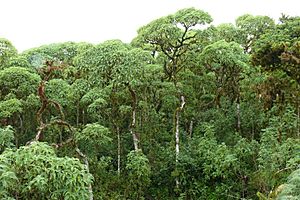Scalesia facts for kids
Quick facts for kids Scalesia |
|
|---|---|
 |
|
| Scalesia pedunculata on Santa Cruz (Galapagos Islands) | |
| Scientific classification |
|
| Kingdom: | Plantae |
| Clade: | Tracheophytes |
| Clade: | Angiosperms |
| Clade: | Eudicots |
| Clade: | Asterids |
| Order: | Asterales |
| Family: | Asteraceae |
| Supertribe: | Helianthodae |
| Tribe: | Heliantheae |
| Subtribe: | Helianthinae |
| Genus: | Scalesia Arn. |
| Species | |
|
|
Scalesia is a special group of plants that includes shrubs and trees. They are found only on the Galapagos Islands. This means they are endemic to the islands, which means they don't grow naturally anywhere else in the world. It's quite unusual for trees to be part of the Asteraceae family, which mostly includes plants like daisies and sunflowers.
About Scalesia Plants
The name Scalesia came from a small mistake! A botanist named Arnott meant to name it after William Alexander Stables, another botanist. But he accidentally wrote "Scales" instead.
All Scalesia plants have soft wood inside, which is called pith. Scientists sometimes call Scalesia plants "the Darwin's finches of the plant world." This is because they have changed and adapted to their different island homes in many amazing ways, just like Darwin's famous finches. This process is called adaptive radiation.
Different Types of Scalesia
One of the biggest and most common Scalesia species is Scalesia pedunculata. This large tree can grow up to 15 to 20 metres tall, which is about as tall as a five-story building! It grows very quickly, reaching its full size in just a few years.
These trees often grow close together in large groups. All the trees in one group are usually the same age. They tend to die around the same time. After they die, new young plants grow up in the same spot, starting a new generation.
The biggest groups of Scalesia pedunculata trees are found on the wet, windy sides of Santa Cruz, San Cristóbal, Santiago, and Floreana islands. They grow at a height of about 400 to 700 metres above sea level. The most famous group of these trees is on Santa Cruz Island, and a road even goes through it.
Two other smaller tree species are Scalesia atractyloides and S. stewartii. These two species look very similar to each other.
See also
 In Spanish: Scalesia para niños
In Spanish: Scalesia para niños

